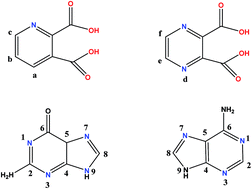Synthesis, characterization, and DNA interaction of novel Pt(ii) complexes and their cytotoxicity, apoptosis and molecular docking†
Abstract
The complexes [Pt{Ar(COOH)2}(OH)2] (1), [Pt{Ar(COOH)2}(OH)2]·H2O (2) have been synthesized and characterized by IR, 1H NMR, element analysis and single-crystal X-ray diffractometry. The interaction of the Pt(II) complexes with fish sperm DNA was explored by UV absorption, fluorescence spectroscopy and viscosity measurements. The results indicated that the complexes bind to FS-DNA in an intercalative mode with different binding affinities. The reaction of the complexes with N7, N3/N9 from guanine and adenine were investigated by 1H NMR. A gel electrophoretic assay demonstrated the ability of the Pt(II) complexes to cleave the pBR322 plasmid DNA. The docking methods were used to predict the DNA binding affinity of Pt(II) complexes by the resulting relative binding energy with DNA with −6.74 kcal mol−1 (complex 1) and −6.21 kcal mol−1 (complex 2). The cytotoxic activity of the complexes was tested against Hela cancer cell lines. The two complexes showed cytotoxic specificity and a significant cancer cell inhibitory rate. Complex 1 possessed the highest inhibition on viability of tested cells. Furthermore, the apoptotic tests indicated that the complexes had an apoptotic effect on HeLa cells.


 Please wait while we load your content...
Please wait while we load your content...